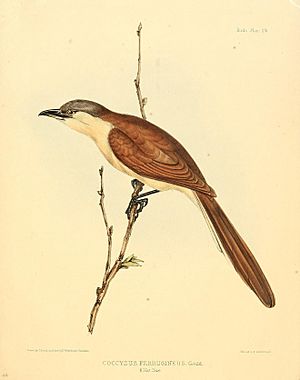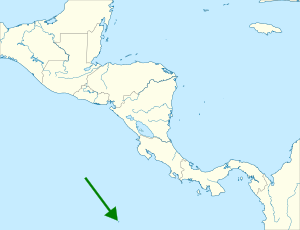Cocos cuckoo facts for kids
Quick facts for kids Cocos cuckoo |
|
|---|---|
 |
|
| Conservation status | |
| Scientific classification | |
| Genus: |
Coccyzus
|
| Species: |
ferrugineus
|
 |
|
The Cocos cuckoo (Coccyzus ferrugineus) is a special type of bird that lives only on Cocos Island. This island is located in the Pacific Ocean and belongs to Costa Rica. The Cocos cuckoo is considered a Vulnerable species, which means it needs protection because its numbers are not very high. It is part of the cuckoo family, known as Cuculidae.
Contents
What is a Cocos Cuckoo?
How is the Cocos Cuckoo Classified?
The Cocos cuckoo was once thought to be a type of mangrove cuckoo. Now, scientists know they are different but very close relatives, like "sister species". Other cuckoos, like the pearly-breasted cuckoo and the yellow-billed cuckoo, are also related. The Cocos cuckoo is monotypic, which means it is the only species in its group and does not have any subspecies.
What Does Its Name Mean?
The first part of its scientific name, Coccyzus, comes from an Ancient Greek word. It sounds like the call of a common cuckoo. The second part, ferrugineus, is a Latin word meaning "rusty". This refers to the reddish-brown color on the bird's upper body.
Appearance of the Cocos Cuckoo
How Big is This Bird?
The Cocos cuckoo is about 32 to 33 centimeters (12.6 to 13 inches) long. About half of its length is its tail! It weighs around 70 grams (2.5 ounces), which is about as much as a small apple.
What Does it Look Like?
This bird has a strong bill that curves slightly downwards. The top part of its bill (maxilla) is black. The bottom part (mandible) is yellow or orange-yellow with a black tip. Both male and female Cocos cuckoos look the same.
Adult birds have a dark gray forehead and head. Their upper body is grayish-brown. Their wings are a reddish-brown color. The top of their tail is grayish-brown, but the underside is black with wide white tips. They have a thin black "mask" around their eyes. The skin around their eyes is yellow or orange-yellow. Their throat and chest are a creamy white, and their belly is a rich, warm tan color.
Young Cocos cuckoos look similar to adults. However, their head and back colors are not as different. Their face mask is also less noticeable. Their throat, chest, and belly are whiter, and they have less white on their tail.
Where Do Cocos Cuckoos Live?
Cocos Island: Their Only Home
The Cocos cuckoo lives only on Cocos Island. This island is about 550 kilometers (340 miles) off the Pacific coast of Costa Rica. It is the only place in the world where you can find this bird!
What Kind of Places Do They Like?
These cuckoos live almost everywhere on the island. They use many different types of plant areas. This includes forests that get flooded, forests along rivers, tropical rainforests, and even cloudforests. You can find them from the sea level all the way up to the highest points on the island, which are about 450 meters (1,480 feet) high.
Cocos Cuckoo Behavior
Movement and Daily Life
The Cocos cuckoo stays on Cocos Island all year long. During the time they are raising their young, they often stay at the edges of the forest. When they are not breeding, they tend to move deeper into the forest.
How Do They Get Around?
These birds usually make only short flights. They often move through trees by hopping along branches. They also use short flutters and glides to get from one spot to another.
What Do They Eat?
Adult Cocos cuckoos mostly eat caterpillars. They especially like the caterpillars of the giant sphinx moth and the Orion cecropian butterfly. Young cuckoos are fed crickets and cockroaches.
Their hunting style changes depending on where they are. They might hunt on the ground with short flights. They also pick insects off plants in the lower parts of the forest. Sometimes, they even search inside Guzmania sanguinea bromeliad plants that grow on Sacoglottis holdridgei trees. Besides insects, they sometimes eat a type of lizard called Anolis towsendi, which also lives only on Cocos Island.
Reproduction and Life Cycle
The Cocos cuckoo breeds during the dry season, which is from January to mid-April. Both the male and female birds work together to build a nest. Their nest is a simple cup made of sticks with no soft lining inside. They usually place it on a small branch of a small tree. The nests found were about 2.5 meters (8 feet) above the ground and were partly hidden by leaves.
Both parents share the job of sitting on the eggs (incubation) and taking care of the young. We don't know exactly how many eggs they lay, but scientists think it's usually one or two. The time it takes for the eggs to hatch is also not fully known. However, it is probably similar to other cuckoos in their family, which is about nine to 12 days. The time it takes for the young birds to leave the nest is also not yet known.
What Do They Sound Like?
It is quite rare to hear the Cocos cuckoo's calls recorded. As of late 2022, there were very few recordings available. Their song is described as a deep, rumbling sound like "Eeh-eeh-eeh-eeh-eeh-eeeh-eeeehh". They sing most often during the breeding season, usually between sunrise and noon.
Status and Protection
Why is the Cocos Cuckoo Vulnerable?
The IUCN (International Union for Conservation of Nature) has listed the Cocos cuckoo as a Vulnerable species. This means it faces a risk of becoming endangered. It lives in a very small area, only on Cocos Island. Scientists estimate there are between 250 and 1,000 adult birds, and this number seems to be stable for now.
What Threats Do They Face?
Several things could harm the Cocos cuckoo. Wild cats, pigs, and goats are potential threats. Cats might hunt the birds. Pigs and goats, along with deer, can damage the places where the cuckoos live by eating plants. More and more tourists are visiting the island, which can also disturb the birds. Finally, climate change is another possible threat to their future.
See also
 In Spanish: Cuclillo de isla del Coco para niños
In Spanish: Cuclillo de isla del Coco para niños


